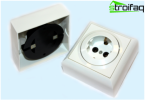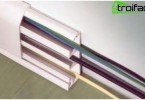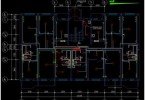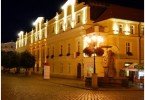Architectural lighting
Architectural lighting is not just beautiful lighting, it is a kind of artistic play of light that installs the shapes of facades into original design ideas. Also, with the help of illuminating the facades of buildings, houses, monuments, you can create an interesting project, emphasize the silhouette of the structure or change the usual daytime view at night. In a word, the illuminated building will definitely not go unnoticed, it will attract the eye, and for advertising purposes such lighting is an indispensable tool.
Content
- The origin of decorative lighting
- Multifunctionality of facade lighting
- Types of architectural lighting of buildings
- Types of used fixtures
The origin of decorative lighting
In fact, architectural outdoor lighting originated in the United States after the end of the First World War, when the prestigious area of New York, namely Manhattan, literally changed, turning into a fabulous night country with illuminated castles in the air – such a message appeared in the newspaper New York Times.
But in Europe, decorative lighting of building facades developed in parallel with the spread of fashion to the aesthetic design of cities. Undoubtedly, European ideas were characterized by a deep sense of style and the sophistication of the taste of architects.
According to the German film director F. Lang, who visited the United States in 1924, the streets of New York turned into screaming abysses of light rotating, spinning, moving, and this is a statement of true happiness. Naturally, the “flashy”, dynamic and chaotic style of America annoyed many European architects, because in Europe there was a clear sense of proportion and centuries-old traditions.
Until 1960, lighting in architecture was secondary, but the number of ideas and solutions was growing rapidly, so there was a need to obtain the level of skill and the corresponding specialized education.
Modern architectural lighting has some features. Firstly, it is aesthetics and functionality. For example, for commercial facilities, such lighting brings practical benefits – attracting attention, remembering the image. Secondly, the issue of energy efficiency is important, because tariffs are rising and costs, respectively, are also rising. Therefore, the time of the lamps goes away and they are replaced by economical LEDs.
Multifunctionality of facade lighting
Skillful application of architectural lighting can have an amazing result. Plus, it is possible to spot, multi-colored, contour lighting, and if desired, you can add dynamics to the design. A competent lighting designer can amazingly design a building: emphasize details that are almost indistinguishable during the day, and at night they take on a completely different look.
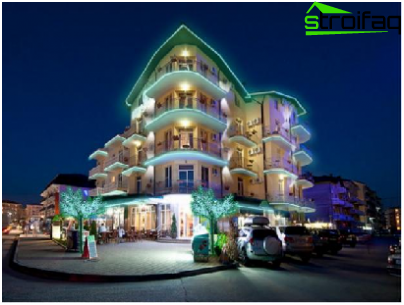
Architectural lighting – a way to highlight the structure, give the facade a special expressiveness
Today, specialists have at their disposal a huge selection of lighting equipment that is easy to install, they do not spoil the holistic look of the building. During the development of the project, specialists take into account all the nuances, subtleties: power, energy consumption, connection points, installation methods, the possibility of convenient maintenance in the future, safety of use, direction of flows. Compliance with building and sanitary standards is also taken into account.
Important: the lighting of the facades of any building is designed to create a unique, luxurious and harmonious ensemble of light and architecture that attracts attention.
It should also be noted that recently the architectural lighting of buildings has become even more interesting, because, for example, it can change depending on the time of year, at the request of the owner, it can be a festive or everyday lighting.
Types of architectural lighting of buildings
If we talk about the basic techniques of outdoor lighting, there are six of them:
- general flood lighting – in terms of design, this is the easiest lighting option. It is perfect for cultural objects (monuments, churches), stand-alone objects, because it remains majestic and holistic perception. Flood lighting is characterized by the installation of spotlights at a certain distance from the illuminated object – most often they are mounted on poles. But it is necessary to take into account the fact that the light directed to the building will pass through the windows, therefore this type of lighting is undesirable for buildings in which people are at night: residential buildings, business centers, hotels;
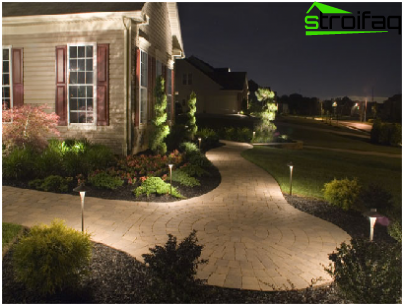
General flood lighting is the easiest way to organize
- local / zone lighting – focusing on facade elements: window openings, arches, cornices, balconies, friezes. In order for the composition to be harmonious, it is necessary to skillfully link all the illuminated details into a single composition. In this version of architectural lighting, medium, low power luminaires are used, as well as linear luminaires based on LEDs. It is LEDs that are becoming increasingly popular at the present time, since they are an excellent replacement for bulky installations with fluorescent lamps;
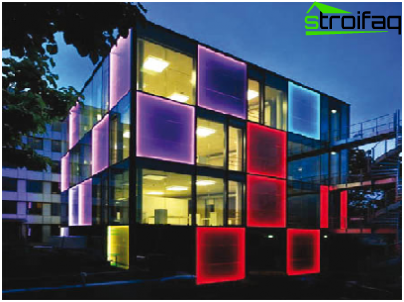
The zonal view of architectural lighting focuses on individual architectural elements
- Background / silhouette lighting is a kind of artistic effect that allows you to achieve the image of the outlines of the shapes of the object, but without any details. The essence of the effect is the creation of a luminous background, that is, the silhouette of the object seems black or dark. At the same time, a clear, strong graphic image is created, and a similar effect is applied to illuminate palaces with columns, theaters;
- light facades – the reception is suitable for lighting modern buildings with full glazing: shopping and entertainment centers, office buildings. Lighting equipment is installed indoors and sent to the glass – a variety of lighting effects are obtained: static or dynamic;
- contour lighting is a fairly new technique when the contour of a building is highlighted with the help of linear fixtures. Such a massive implementation of contour lighting became possible thanks to the appearance of cheap light sources – flexible neon, LED lines. They are installed along the facade in hundreds of meters, for example, they illuminate friezes, corners;
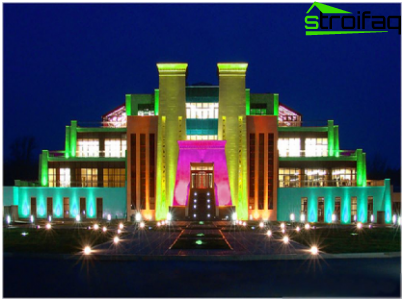
The use of color dynamics – a stunning sight that draws attention to the building, is often used for advertising purposes
- color dynamics is a very interesting lighting method using color synthesis, changing shades for a certain time, increasing / fading brightness. But the methods of using color dynamic systems can be any: flooding, and accent, and silhouette. It uses a variety of color-dynamic luminaires: spotlights, LED rulers, spotlights.
Important: you can still create amazing light patterns, for example, in the form of luminous dots, lines that change color.
Types of used fixtures
Architectural and artistic illumination of facades is created using different lamps:
- searchlights – they are most often used to illuminate facades, as well as to illuminate a common area or for billboards. With the help of spotlights, you can create diffused, soft, spotlight, besides, halogen spotlights have the main advantage – excellent color reproduction, as close as possible to daylight. But there is also a drawback, namely, the speed of lamp burning, because after switching on they do not light up immediately, but only after two minutes. And the lamp can be turned on again after some time;
- luminescent lamps – they are used for architectural illumination of tall buildings. Using these fixtures, you can emphasize the shape of the building or create a light pattern. This backlight is one of the inexpensive types;
- neon lights – used in outdoor advertising and for local lighting of complex configuration elements. The main advantage is giving the neon tube any shape, in addition, with proper operation, the neon light can serve for a long time;
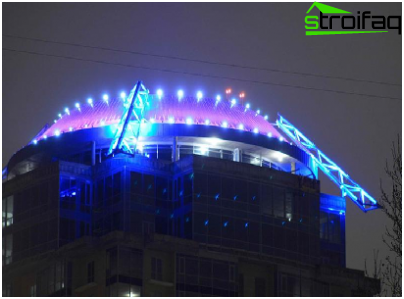
LEDs – a modern solution to reduce energy consumption
- LEDs are the most modern kind of backlight. Architectural LED lightening It is used to highlight geometric shapes, but for complex shapes with window openings, arches, it is not very suitable. For urban areas, this is the most suitable option, besides the most economical: up to 80%, when compared with halogen lamps. The color of the LEDs is incredibly saturated: burgundy, green, red, orange – they can not be categorically placed next to the pale shades of metallogenic lamps. Using a special device, you can program the shades of colors yourself, and there are a lot of them.
Important: LED lighting can be called exclusive, and, as you know, it costs a lot. Lighting projects for some buildings cost hundreds of millions of dollars..
Architectural lighting is in demand today, the main thing is not to forget about the electrical safety and security of the equipment, well, remember the quality of the fixtures.


